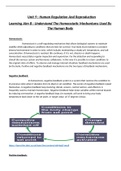Unit 9 : Human Regulation And Reproduction
Learning Aim B : Understand The Homeostatic Mechanisms Used By
The Human Body
Homeostasis:
Homeostasis is a self-regulating mechanism that allows biological systems to maintain
stability while adjusting to conditions that are best for survival. Your body must maintain a constant
internal environment in order to exist, which includes maintaining a steady pH, temperature, and salt
concentration. If homeostasis is reached, life continues; if it is not, disaster or death happens.
Homeostasis necessitates regular inspection and supervision. For the detection and responding to
stimuli the nervous system and hormones collaborate. In this way it is possible to return conditions to
the original state of affairs. To observe and manage internal situations feedback mechanisms are used
by the body. Positive and negative feedback mechanisms are the two types of feedback mechanisms.
Negative feedback:
In homeostasis, negative feedback system is a system that restores the condition to
its previous state when it deviates from its ideal or set condition. The events of negative feedback repeat
themselves. A negative feedback loop involving stimuli, sensors, control centres, and effectors is
frequently used to maintain homeostasis. Negative feedback helps keep variables within normal bounds
by reducing overreaction. A negative feedback loop, for example, will work to bring your body
temperature back down to the set point, or target value, of 37 degrees Celsius.
https://bam.files.bbci.co.uk/bam/live/content/z6h4q6f/small
Positive feedback:





